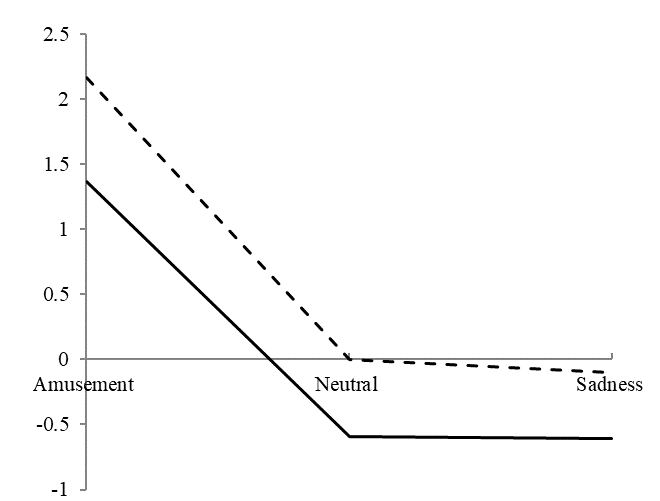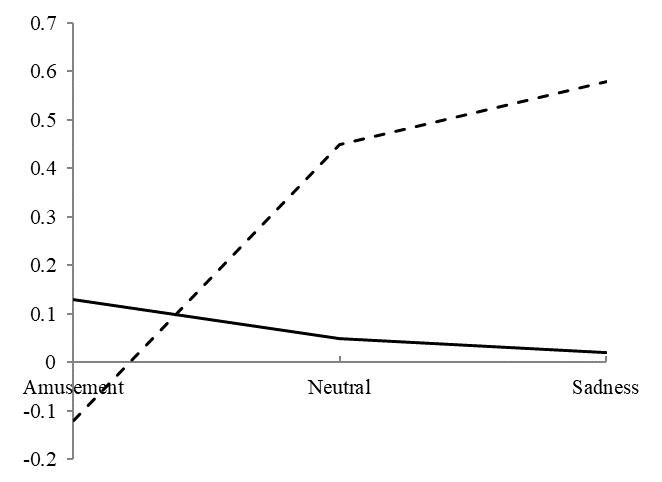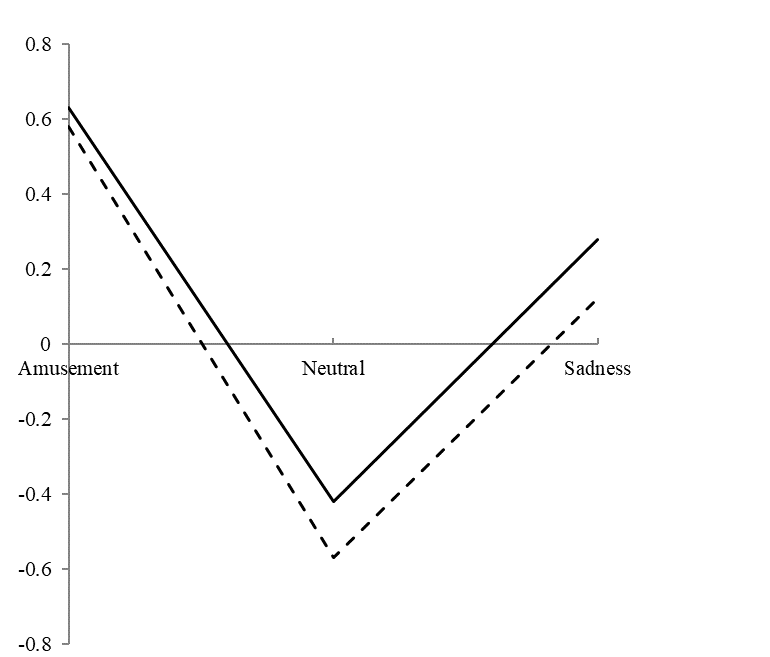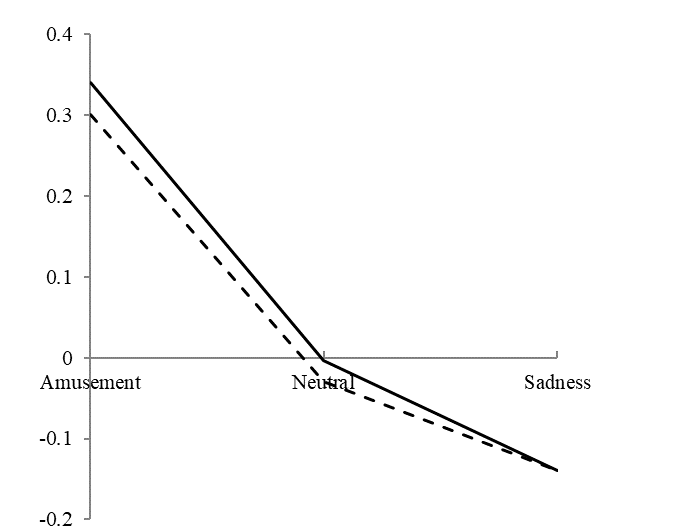Abstract
Past research done in Russian samples demonstrated similar correlations between expressive suppression and the Big Five traits to those found in the United States and in European countries. In Russia, expressive suppression showed a positive association with Conscientiousness and was not related to Agreeableness. Just like in other countries with western cultural values, expressive suppression of negative emotions showed an inverse correlation with psychological well-being, whereas the suppression of positive emotion was not related to well-being. In the present study, we replicated the classical experiment by J. Gross and R. Levenson in a Russian sample (N = 59), aiming to assess the effects of inhibiting positive and negative emotions. Emotions (amusement, sadness, and neutral state) were induced using validated video clips accompanied by an instruction to view normally or with expressive suppression. Under the expressive suppression condition Russians showed: (1) lower activity of cheek muscles, while the forehead muscles toughened under the expressive suppression of amusement and relaxed under the expressive suppression of sadness; (2) the intensity of target emotion did not change, while the expressive suppression of amusement enhanced the background negative emotions, and the expressive suppression of sadness enhanced background positive emotions; (3) the sympathetic activation of the electrodermal and cardiovascular systems did not change. Thus, unlike Americans, for Russians expressive suppression appears to be a typical strategy of emotional regulation that does not cause a decrease in amusement self-reports or additional activation of the sympathetic nervous system.
Keywords: Expressive suppressionamusementsadnessJ GrossRussia
Introduction
Gross (2001, 2015) has proposed a process model of emotion regulation that places the strategies of emotional regulation on the timeline of unfolding emotional response: “Situation – Attention – Appraisal – Response”. According to the model, all strategies of emotional regulation can be divided into antecedent-focused and response-focused, i.e., those that allow one to change the emotional response or to cope with the emotional response that has already been formed. For the present study we chose two strategies of emotional regulation, cognitive reappraisal and expressive suppression, which meet the following criteria: (1) they exemplify antecedent-focused and response-focused emotion regulation strategies; (2) they are used by people in their everyday life; (3) they can be simulated in the laboratory and diagnosed using self-report questionnaires.
Cognitive reappraisal means a change in the attitude to the situation, which allows the emotional response to be modified. Expressive suppression implies an inhibition of the manifestations of a response that has already been formed. Modelling these processes in a laboratory involves inducing an emotional state in participants together with an appropriate instruction (Gross & Levenson, 1997; Gross, 1998). The resulting emotional response can be recorded at the behavioural (facial expressions), experiential (self-reported emotional state), and physiological (sympathetic nervous system activity) levels (Mauss & Robinson, 2009). Individual differences in emotional regulation strategies can be assessed with ERQ (Emotion Regulation Questionnaire), which includes 10 statements (e.g., “I control my emotions by changing the way I think about the situation I’m in”, “I control my emotions by not expressing them”) (Gross & John, 2003).
Past studies have discovered cultural differences in expressive suppression between the United States and East Asian countries (e.g., China). In Americans, the expressive suppression of both positive and negative emotions is accompanied by a decrease in self-reported amusement and an increase in sympathetic activation of the cardiovascular system (Gross & Levenson, 1997). Correlational studies found expressive suppression to be positively associated with depression and negatively associated with life satisfaction, self-esteem, optimism, and well-being (Gross & John, 2003). These findings did not replicate in East Asia, where expressive suppression was not associated with an increase in sympathetic activation of the cardiovascular system (Zhou & Bishop, 2012) and was not correlated with life satisfaction or with depressed mood (Soto, Perez, Kim, Lee, & Minnick, 2011).
These findings can be explained by cultural differences in Individualism versus Collectivism, which underlie the cultural rules pertaining to emotion control. The large-scale studies by Matsumoto et al. (Matsumoto et al., 2008; Matsumoto, Yoo, & Nakagawa, 2008) have found that in cultures with higher levels of collectivism the overall expressivity endorsement tend to be lower (this is especially true for happiness and surprise) and the use of expressive suppression is more frequent. The pronounced cultural differences in the extent of negative consequences of expressive suppression were discovered between the United States and China, countries that belong to the extreme groups on the Individualism scale (91 and 20 points on the scale from 0 to 100; M = 45, SD = 24), according to the data of Hofstede (2019). Thus, when expressive suppression is a typical strategy of emotional regulation, it may entail no negative consequences for the physical and mental health.
The findings using J. Gross’s ERQ questionnaire in a Russian sample reveal a similar correlation pattern between expressive suppression and the Big Five traits to those found in the United States and European countries; however, in Russia expressive suppression was positively related to Conscientiousness and not related to Agreeableness (Pankratova & Kornienko, 2017). This suggests that expressive suppression may be a common strategy of emotional regulation in Russian, where being outwardly reserved does not mean that one is unkind toward others. At the same time, similarly to the US, in Russia expressive suppression shows negative associations with mental health indicators, such as life satisfaction and hardiness.
A recent study in a Russian sample has found that the effects of collectivism on emotional expression are partially mediated by the value of emotional control (Pankratova & Osin, 2019). Horizontal collectivism (social cohesion, interdependence) was associated with open emotional expression, whereas the vertical collectivism (subordination of one’s immediate interests to those of others) was associated with expressive suppression in public settings, which was particularly pronounced for happiness and surprise. Another study has found that Russians, compared to Americans, reported greater expressive suppression of happiness when communicating with strangers (Sheldon et al., 2017). Furthermore, the degree of expressive suppression of happiness was negatively associated with subjective well-being in the US but was not related to subjective well-being in Russian samples.
Problem Statement
According to Hofstede’s (2019) data, Russia occupies a median position on the Individualism scale (39 points on the scale from 0 to 100; M = 45, SD = 24), but is closer to China (Collectivism pole, 20 points) than to the United States (Individualism pole, 91 points). The meta-analytic finding show that expressive suppression is negatively associated with mental health indicators in individualistic countries (e.g., United States and United Kingdom), but not in collectivistic ones (e.g., China, Japan) (Hu et al., 2014). The Russian samples tend to show ambiguous results: like in individualistic countries, the overall expressive suppression is negatively associated with the indicators of mental health, but, like in collectivistic countries, the suppression of positive emotions shows no correlation with mental health.
Research Questions
The main research question was whether the expressive suppression of positive and negative emotion in Russians would result in activation of sympathetic nervous system.
Purpose of the Study
The purpose of the study was to investigate the effects of inhibiting positive and negative emotions in Russia.
Research Methods
Participants
The participants were 59 female students of Moscow State University and National Research University Higher School of Economics aged from 17 to 25 (M = 21, SD = 2), all of them Russian, according to self-report.
Film Stimuli
We used stimulus videos to induce amusement (“Child”―a laughing child), a neutral state (“Alaska”―Alaska landscapes), and sadness (a fragment of the feature film “The Champ”―a boy cries at his father’s death). Another neutral video (“Dolphins”-submarine life and a shoal of porpoises) was used to introduce the participants into the experimental situation. The videos have been chosen based on pre-test of several videos in a Russian sample (Pankratova & Lyusin, 2018), with “The Champ” and “Alaska” originating from J. Gross’s video database (Gross & Levenson, 1995; Rottenberg, Ray, & Gross, 2007).
Procedure
The participants were shown videos inducing amusement, neutral state, and sadness (the order of amusement and sadness films was counterbalanced). They were randomly assigned to the free viewing condition (control group) or the expressive suppression condition (experimental group). The emotional response was recorded at three levels: (1) self-reported emotional state using 10 emotional terms (two terms for each scale: amusement, sadness, anger, disgust, fear) rated on a 6-point Likert scale (0 to 5); (2) facial expression was measured using electromyografic self-adhesive electrodes attached to musculus risorius (cheek skin) and musculus corrugator supercilii (forehead skin) (EMG_Cheek_M, EMG_Cheek_L, EMG_Forehead_M, EMG_Forehead_L); (3) the activity of the sympathetic nervous system was assessed via skin conductance level (SCL_M, SCL_L) and electrocardiogram (LF, HF). The presentation of stimuli and the recording of physiological indicators were performed using the Rehacor system.
Data processing
The processing of physiological data involved three stages: (1) first, we formed aggregated indices of cheek and forehead muscle activity and of galvanic skin response as products of the corresponding mean amplitude and the length of the response; we also calculated the LF/HF ratio as a measure of sympathetic activation; (2) we divided the responses to the three experimental videos by their baseline levels (averaged across the pre-experiment and post-experiment periods); (3) finally, because these variables showed a log-normal distribution, we used a logarithmic transformation in order to apply parametric methods.
Findings
To find out the effects of the suppression instruction on the participants' subjective experience, expressive behaviour, and physiological indicators, we conducted a 2 × 3 Mixed ANOVA [Condition (suppression vs no suppression) × Film (amusement, neutral, and sadness)] for each dependent variable with Tukey post hoc tests.
Subjective experience
For the self-report on the target emotions (amusement, sadness) and the overall emotional impact, the only significant effects were the main effects of the film: (1) for amusement (F (2; 114) = 97.25, p < 0.001, η2 = 0.63) the amusement film had a higher rating, compared to the two other films, and the neutral film was rated higher than the sadness film; (2) for sadness (F (2; 114) = 92.22, p < 0.001, η2 = 0.62), the sadness film was rated higher than the amusement and neutral films; (3) for the overall emotional impact (F (2; 114) = 35.56, p < 0.001, η2 = 0.38), the amusement and sadness films did not differ and were both rated significantly higher than the neutral film. In addition, we compared the self-reports on all emotional terms between the two experimental conditions using Mann–Whitney U-test: (1) during the amusement film, participants in the suppression condition reported higher levels of sadness (“depression”: p < 0.05) and of negative emotions in general (p = 0.088), compared to the control group; (2) during the sadness film, suppression participants reported higher amusement (“joy”: p < 0.05) than did participants in the control condition.
Expressive behaviour
For the cheek muscles (see Fig.


Note: The dashed line is for the usual viewing, and the full line is for viewing with suppressed expression. During the viewing of neutral and sad films, the activity of forehead muscles was higher than that during the viewing of joyous films. The suppression of joy expression was associated with tense forehead muscles, and the suppression of sadness expression, with their relaxation
Physiology
For skin conductance (see Figure

Note: The dashed line is for the usual viewing, and the full line is for expressive suppression. Skin conductance during the viewing of a joy and sadness films was higher than that in the case of a neutral film, and it did not change with changing viewing conditions

Note: The dashed line is for usual viewing, and the full line is for expressive suppression. The sympathetic activation was higher during a joy film than it was during neutral and, even more, sadness films; it did not change with changes in viewing conditions
Conclusion
1. Expressive suppression in Russians, unlike Americans, does not result in a decrease in self-reported amusement or in additional sympathetic nervous system activation. At the same time, as in the case with Americans, it shows a negative correlation with psychological well-being (except for the expressive suppression of positive emotion).
2. During the expressive suppression of positive and negative emotions Russians show a decrease in the cheek muscle activity, whereas the forehead muscles tense during the suppression of amusement and relax during the suppression of sadness.
3. The expressive suppression of positive and negative emotions in Russians has no effect on the intensity of the target emotion, although the suppression of amusement causes an increase in the background negative emotions, while the suppression of sadness causes an increase in the background positive emotions.
Acknowledgments
The study was supported by the Russian Foundation for Basic Research, project No 16-06-00363 “Culture values and emotion display rules”.
References
- Bityutskaya, E. V. (2016) Stsenarii bezvykhodnosti pri perezhivanii trudnoi zhiznennoi situatsii [Scenario of Hopelessness in Difficult Life Situation]. In T. L., Krukova, M. V., Saporovskaia, & S. A., Khazova (Eds.), Psikhologiya stressa i sovladayushchego povedeniya: resursy, zdorov'e, razvitie [Stress and coping psychology: Resources, health, and development] (pp. 220–222). Kostroma, Russia: Kostroma State University. [In Russian]
- Gross, J. J. (1998). Antecedent- and response-focused emotion regulation: Divergent consequences for experience, expression, and physiology. Journal of Personality and Social Psychology, 74(1), 224–237.
- Gross, J. J. (2001). Emotion regulation in adulthood: Timing is everything. Current Directions in Psychological Science, 10, 214–219.
- Gross, J. J. (2015). Emotion Regulation: Current Status and Future Prospects. Psychological Inquiry, 26(1), 1–26.
- Gross, J. J., & John, O. P. (2003). Individual differences in two emotion regulation processes: Implications for affect, relationships, and well-being. Journal of Personality and Social Psychology, 85(2), 348–362.
- Gross, J. J., & Levenson, R. W. (1995). Emotion Elicitation Using Films. Cognition and Emotion, 9(1), 87–108.
- Gross, J. J., & Levenson, R. W. (1997). Hiding feelings: The acute effects of inhibiting negative and positive emotion. Journal of Abnormal Psychology, 106(1), 95–103.
- Hofstede, G. (2019). Research and VSM. Dimension data matrix. Retrieved from https://geerthofstede.com
- Hu, T., Zhang, D., Wang, J., Mistry, R., Ran, G., & Wang, X. (2014). Relation between emotion regulation and mental health: a meta-analysis review. Psychological Reports: Measures & Statistics, 114(2), 341–362.
- Matsumoto, D., Yoo, S. H., Fontaine, J., Anguas-Wong, A. M., Arriola, M., Ataca, B., … Grossi, E. (2008). Mapping expressive differences around the world: The relationship between emotional display rules and individualism versus collectivism. Journal of Cross-Cultural Psychology, 39(1), 55–74.
- Matsumoto, D., Yoo, S. H., & Nakagawa, S. (2008). Culture, emotion regulation, and adjustment. Journal of Personality and Social Psychology, 94(6), 925–937.
- Mauss, I. B., & Robinson, M. D. (2009). Measures of emotion: A review. Cognition and Emotion, 23(2), 209–237.
- Mauss, I. B., Butler, E. A. (2010). Cultural context moderates the relationship between emotion control values and cardiovascular challenge versus threat responses. Biological Psychology, 84(3), 521–530.
- Pankratova, A. A., & Kornienko, D. S. (2017). Russkoyazychnaya adaptatsiya oprosnika ERQ (Emotion Regulation Questionnaire) G. Gross. [A Russian Adaptation of the Emotional Regulation Questionnaire (G. Gross)]. Voprosy psikhologii [Issues of Psychology], 5, 139–149. [In Russian]
- Pankratova, A. A., & Lyusin D. (2018). Videoroliki dlya induktsii emotsii v laboratornykh usloviyakh: normativnye dannye i kross-kul'turnyi analiz [Videos for eliciting emotions in the laboratory settings: Normative data and cross-cultural analysis]. Eksperimental'naya psikhologiya [Experimental Psychology], 11(2), 5–15. [In Russian, abstract in English]
- Pankratova, A. A., & Osin, E. N. (2019). Krugovaya model' pravil proyavleniya emotsii: kross-kul'turnoe issledovanie [Circumplex Model of Emotional Display Rules: A Cross-cultural Study]. Psikhologicheskii zhurnal [Psychological Journal]. In Press. [In Russian, abstract in English]
- Rottenberg J., Ray, R. D., & Gross J. J. (2007). Emotion Elicitation Using Films. In J. A. Coan & J. J. Allen (Eds.), The Handbook of Emotion Elicitation and Assessment (pp. 9–28). New York: Oxford University Press.
- Sheldon, K. M., Titova, L., Gordeeva, T. O., Osin, E. N., Lyubomirsky, S., & Bogomaz, S. (2017). Russians inhibit the expression of happiness to strangers: Testing a display rule model. Journal of Cross-Cultural Psychology, 48(5), 718–733.
- Soto, J. A., Perez, C. R, Kim, Y-H, Lee, E. A., & Minnick, M. R. (2011). Is expressive suppression always associated with poorer psychological functioning? A cross-cultural comparison between European Americans and Hong Kong Chinese. Emotion, 11(6), 1450–1455.
- Zhou, T., & Bishop, G. D. (2012). Culture moderates the cardiovascular consequences of anger regulation strategy. International Journal of Psychophysiology, 86(3), 291–298.
Copyright information

This work is licensed under a Creative Commons Attribution-NonCommercial-NoDerivatives 4.0 International License.
About this article
Publication Date
14 July 2019
Article Doi
eBook ISBN
978-1-80296-063-1
Publisher
Future Academy
Volume
64
Print ISBN (optional)
-
Edition Number
1st Edition
Pages
1-829
Subjects
Psychology, educational psychology, counseling psychology
Cite this article as:
Pankratova*, A. A., Osin, E. N., Lebedev, V. V., Kiselnikov, A. A., & Sergeev, A. A. (2019). The Effects Of Emotional Expression Inhibition In Russians. In T. Martsinkovskaya, & V. R. Orestova (Eds.), Psychology of Subculture: Phenomenology and Contemporary Tendencies of Development, vol 64. European Proceedings of Social and Behavioural Sciences (pp. 484-492). Future Academy. https://doi.org/10.15405/epsbs.2019.07.63
